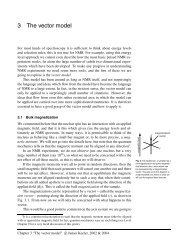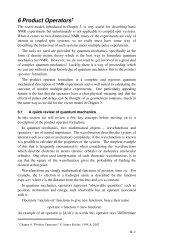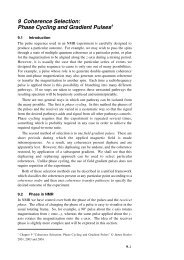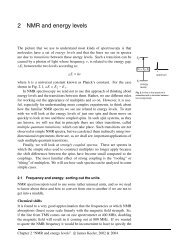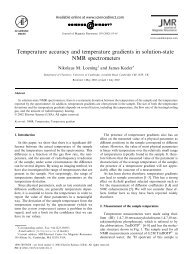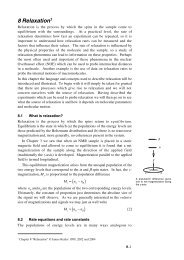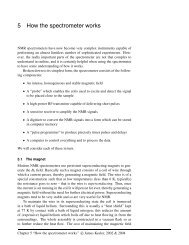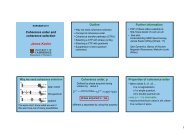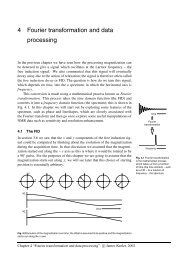Elimination of Zero-Quantum Interference in Two-Dimensional NMR ...
Elimination of Zero-Quantum Interference in Two-Dimensional NMR ...
Elimination of Zero-Quantum Interference in Two-Dimensional NMR ...
You also want an ePaper? Increase the reach of your titles
YUMPU automatically turns print PDFs into web optimized ePapers that Google loves.
Communications<br />
The key feature <strong>of</strong> our new method is that suppression <strong>of</strong><br />
zero-quantum coherence is achieved <strong>in</strong> a s<strong>in</strong>gle scan; no<br />
repetition <strong>of</strong> the experiment is necessary. This represents a<br />
very significant improvement over the usual method <strong>of</strong> zeroquantum<br />
suppression, which is to repeat the experiment for a<br />
range <strong>of</strong> mix<strong>in</strong>g times <strong>of</strong> the order <strong>of</strong> 2p/W ZQ . [1] Not only does<br />
this greatly extend the m<strong>in</strong>imum required experiment time,<br />
but it is also difficult to choose a small set <strong>of</strong> mix<strong>in</strong>g-time<br />
values which give adequate suppression over a range <strong>of</strong> zeroquantum<br />
frequencies. The alternative approach <strong>of</strong> vary<strong>in</strong>g the<br />
mix<strong>in</strong>g time randomly from one t 1 <strong>in</strong>crement to the next<br />
merely transforms the unwanted signals <strong>in</strong>to t 1 noise. [1]<br />
In a previous study we showed how sp<strong>in</strong>-lock<strong>in</strong>g <strong>in</strong> the<br />
presence <strong>of</strong> an <strong>in</strong>homogeneous B 0 or B 1 field can also result <strong>in</strong><br />
the dephas<strong>in</strong>g <strong>of</strong> zero-quantum coherence. [4] However, the<br />
technique proposed here<strong>in</strong> is far superior to our earlier work<br />
<strong>in</strong> that the new approach is simpler to implement, leads to<br />
faster dephas<strong>in</strong>g <strong>of</strong> the zero-quantum coherence, and does not<br />
suffer from additional complications, such as unwanted<br />
TOCSY-type transfer.<br />
Figure 2 compares part <strong>of</strong> the NOESY spectrum <strong>of</strong><br />
strychn<strong>in</strong>e recorded with and without the new zero-quantum<br />
suppression method; a short mix<strong>in</strong>g time t m <strong>of</strong> 400 ms has<br />
been used, as it is under these conditions that the anti-phase<br />
contributions are most troublesome. Figure 2a shows a<br />
spectrum recorded without zero-quantum suppression; the<br />
significant phase distortions on both the diagonal- and crosspeak<br />
multiplets arise from the zero-quantum coherence<br />
present dur<strong>in</strong>g the mix<strong>in</strong>g time. Figure 2a’ shows a spectrum<br />
recorded us<strong>in</strong>g the new zero-quantum suppression method:<br />
the anti-phase dispersive contributions are removed, which<br />
leaves all <strong>of</strong> the peaks <strong>in</strong> pure absorption—the improvement<br />
is dramatic (the rema<strong>in</strong><strong>in</strong>g <strong>in</strong>tensity distortions result from a<br />
comb<strong>in</strong>ation <strong>of</strong> strong coupl<strong>in</strong>g and flip-angle effects).<br />
Clearly, one-dimensional NOE experiments, such as the<br />
double-pulsed field gradient sp<strong>in</strong> echo (DPFGSE) NOE,<br />
which also require zero-quantum suppression, will benefit<br />
from the same approach.<br />
There are other experiments <strong>in</strong> which the new zeroquantum<br />
suppression method can be used to good effect; here<br />
we consider just two: z-COSY and TOCSY. The z-COSY<br />
experiment is similar to NOESY except that the two pulses<br />
bracket<strong>in</strong>g the mix<strong>in</strong>g period have small flip angles, typically<br />
208. [6] In the result<strong>in</strong>g spectrum both the cross- and diagonalpeak<br />
multiplets have absorption-mode l<strong>in</strong>e shapes and, most<br />
importantly, the multiplets are “reduced”, thus mak<strong>in</strong>g it<br />
possible to measure both the size and relative sign <strong>of</strong> passive<br />
coupl<strong>in</strong>gs.<br />
Effective suppression <strong>of</strong> zero-quantum coherences that<br />
are present between the two small flip angle pulses is crucial<br />
to the success <strong>of</strong> the z-COSY experiment; the pulse sequence<br />
<strong>in</strong> Figure 1b shows how this can be achieved by us<strong>in</strong>g the new<br />
method. Figure 2b shows part <strong>of</strong> the z-COSY spectrum <strong>of</strong><br />
strychn<strong>in</strong>e recorded without zero-quantum suppression; significant<br />
dispersive contributions obscure the f<strong>in</strong>e structure <strong>of</strong><br />
the multiplets. <strong>Zero</strong>-quantum suppression gives the dramatic<br />
improvement shown <strong>in</strong> Figure 2b’: the l<strong>in</strong>e shapes are<br />
absorptive and the reduced multiplets can now clearly be<br />
seen.<br />
Figure 2. Comparison <strong>of</strong> spectra recorded without zero-quantum suppression<br />
(left) and with (right) the new swept-pulse/gradient method<br />
for the suppression <strong>of</strong> zero-quantum coherence; a, a’): NOESY spectra<br />
(mix<strong>in</strong>g time 400 ms), b, b’): z-COSY spectra, and c, c’): TOCSY spectra<br />
(mix<strong>in</strong>g time 23 ms). The same region <strong>of</strong> the spectrum <strong>of</strong> strychn<strong>in</strong>e is<br />
shown <strong>in</strong> each case. The spectra on the left all show dispersive antiphase<br />
contributions aris<strong>in</strong>g from zero-quantum coherence present<br />
dur<strong>in</strong>g the mix<strong>in</strong>g time. In the spectra shown on the right, these contributions<br />
have been removed by the new dephas<strong>in</strong>g method; as a result,<br />
the spectra show pure absorption l<strong>in</strong>e shapes and are thus much<br />
easier to <strong>in</strong>terpret. Positive contours are <strong>in</strong>dicated by full l<strong>in</strong>es, negative<br />
contours by dashed l<strong>in</strong>es; the F 1 -axis is vertical.<br />
F<strong>in</strong>ally, we consider TOCSY (total correlation spectroscopy)<br />
experiments. [7] Aga<strong>in</strong>, the pulse sequence is similar to<br />
that used <strong>in</strong> NOESY experiments except that an isotropic<br />
mix<strong>in</strong>g sequence (such as DIPSI-2) is applied dur<strong>in</strong>g the<br />
mix<strong>in</strong>g time. Such a sequence results <strong>in</strong> the <strong>in</strong>terchange <strong>of</strong> z-<br />
magnetization between coupled sp<strong>in</strong>s via a state <strong>of</strong> zeroquantum<br />
coherence. To obta<strong>in</strong> spectra with pure phase, it is<br />
necessary to dephase zero-quantum coherence present both<br />
before and after the period <strong>of</strong> isotropic mix<strong>in</strong>g; a suitable<br />
pulse sequence is shown <strong>in</strong> Figure 1c. Note that to avoid the<br />
zero-quantum coherence dephased by the first swept-pulse/<br />
gradient pair be<strong>in</strong>g rephased <strong>in</strong> the second, different durations<br />
(t f1 and t f2 ) must be used.<br />
2 2003 Wiley-VCH Verlag GmbH & Co. KGaA, We<strong>in</strong>heim www.angewandte.org Angew. Chem. Int. Ed. 0000, 00, 0–0



